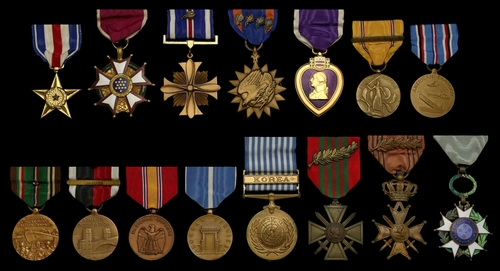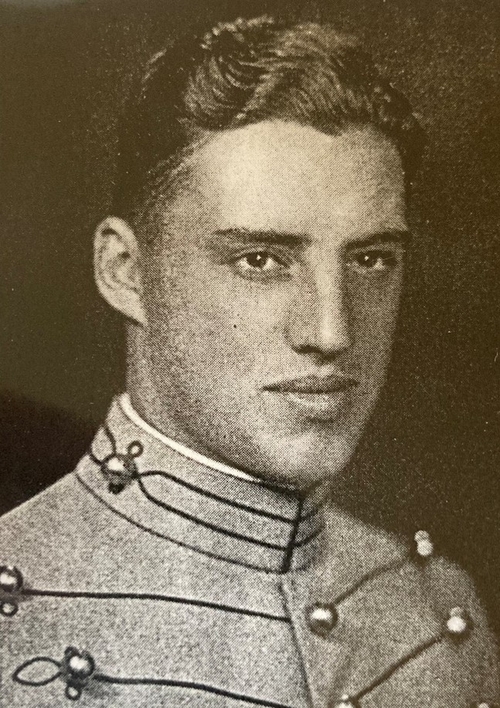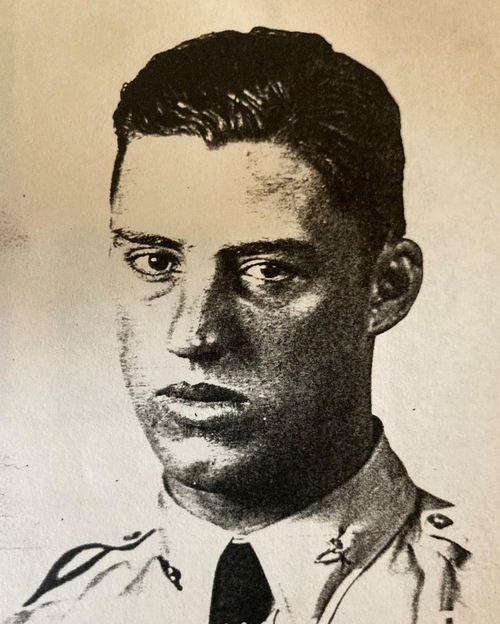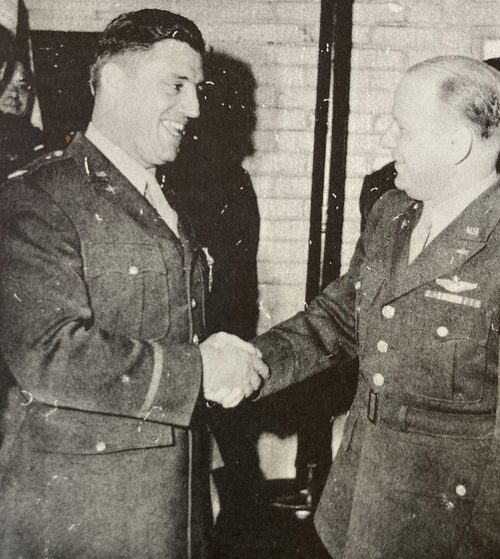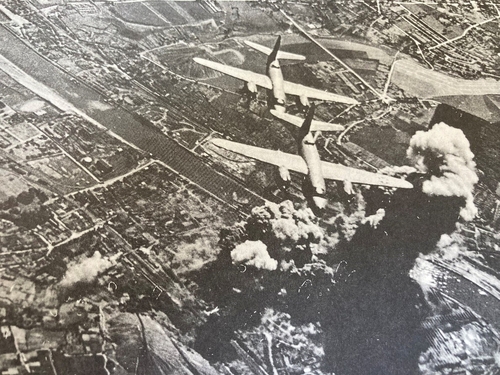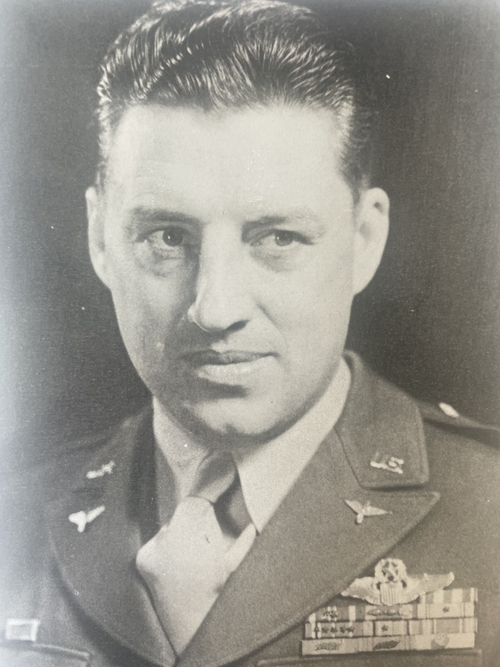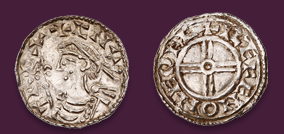Auction: 25002 - Orders, Decorations and Medals
Lot: 310
'Colonel Hall had led the group in combat for 10 months …To say Colonel Hall was admired and respected by the men who served under him would be a gross understatement. Although in his mid-thirties, he was affectionately known as the "old man", from the lowliest private right up the line to the top officers on his staff. To the combat crews, Colonel Hall was a legend. He led them through some of the heaviest flak that the Nazis were able to muster. Whenever the "old man's" name was on the board to lead the group, a shudder of anticipation passed through the crews, because they knew he did not pick the "milk runs" (easy missions). He was in that lead ship for one reason; that reason was to lead the group into and drop their bombs on the selected target of the day, and then to return them by the safest route possible back to base. At this job of par-excellent flying, Colonel Hall was second to none.'
Major J. Guy Ziegler's Bridge Busters - The Story of the 394th Bomb Group, refers.
The exceptional Second World War U.S. 'Marauder' pilot's Silver Star, D.F.C. and Air Medal, Korean War posthumous Legion of Merit and Purple Heart group of fourteen awarded to Colonel T. B. 'Tom' Hall, United States Air Force, late United States Army Air Force
A graduate of West Point, Hall elected to pursue a career in the U.S.A.A.F., among his peacetime duties being to stand in as a 'double' for Clark Gable in the making of the movie Test Pilot, an undertaking that led to him being offered an acting contract on the spot
In the more serious business of B-26 Marauder operations over France, Belgium and Germany in 1944-45, in which he commanded 394th Bomb Group, he flew around 50 flak-ridden sorties of the hair-raising kind, not least at the time of the Normandy landings: on one occasion his aircraft 'was knocked out of the air with 200 flak holes but after a crash landing he was able to walk away'
Tragically, the Colonel - who was surely marked out for senior command - was posted missing after a sortie over Korea in February 1951
United States of America, Silver Star, the reverse inscribed 'Thomas B. Hall'; Legion of Merit, Legionnaire's breast Badge, gilt metal and enamel, the reverse inscribed 'Thomas B. Hall'; Distinguished Flying Cross, with cluster, the reverse engraved 'Thomas B. Hall'; Air Medal, with 4 clusters, the reverse engraved 'Thomas B. Hall'; Purple Heart, the reverse inscribed 'Thomas B. Hall'; Defence Service Medal, clasp, Foreign Service; American Campaign Medal; European/African/Middle Eastern Campaign Medal, with silver star; Army of Occupation, clasp, Japan; American Defence Medal; Korean Service Medal; United Nations Medal for Korea; France, Croix de Guerre, with palme; Belgium, Croix de Guerre, with palme; Brazil, Order of the Southern Cross, Officer's breast Badge, together with his metalled Pilot's Wings, by N.S. Meyer Inc., New York, and uniform lapel badges (2), and embroidered uniform unit patches (2), generally very fine or better (19)
Silver Star Ninth Air Force order dated 24 January 1945:
'For gallantry in action while participating in aerial flight against the enemy in the European theatre of operations on 28 August 1944. On this date Colonel Hall led a formation of B-26 aircraft in an attack on German troop concentrations along the banks of the Seine. At the beginning of the attack the formation was subjected to intense, accurate enemy anti-aircraft fire, which was concentrated on the formation led by Colonel Hall. Although heavy haze, dense battle smoke and intense opposition greatly complicated bombing operations, Colonel Hall gallantly led his formation through a barrage of enemy fire and his target was bombed with devastating effect. Colonel Hall's gallant and courageous leadership, an utter disregard of personal danger on this occasion, are symbolic of the highest traditions of the Army Air Forces.'
Legion of Merit: a posthumous award presented to the Colonel's widow by Major-General Earle E. Partridge, C.O. of the Fifth Air Force, at Johnson Air Base in March 1951.
D.F.C. Ninth Air Force order dated 30 June 1944:
'For extraordinary achievement in aerial flight against the enemy while serving as group commander of a formation of B-26 aircraft attacking a special military installation on 22 April 1944. During the bombing run, the aircraft piloted by Colonel Hall received repeated hits from anti-aircraft fire which caused extensive damage and seriously wounded the co-pilot. In the face of extremely hazardous obstacles, Colonel Hall maintained his secure leadership of the formation, leading his group to bomb the target with unusual effectiveness. The brilliant leadership, exceptional flying skill and unswerving devotion to duty displayed by Colonel Hall is in keeping with the highest traditions of the Army Air Forces.'
Cluster to D.F.C. Ninth Air Force order dated 15 August 1944:
'For distinguished and meritorious achievement while leading a group of B-26 aircraft on a bombing mission over vitally important enemy installations on 12 June 1944. Though subjected to violent and accurate flak fire throughout this unusually deep and hazardous penetration of enemy territory, he skilfully and with great coolness and courage evaded it with minimum loss and made a straight and level bomb run with his group and hit the target with devastating results. Colonel Hall's skill, courage and devotion to duty in the face of intense enemy fire was an inspiration to the members of his group and reflects the highest credit upon himself and upon the Armed Forces of the United States.'
Air Medal Ninth Air Force order dated 25 April 1944, followed by a final tally of 2 silver clusters and 4 bronze ones.
Thomas Burns Hall was born in Chama, New Mexico on 26 September 1910, where he attended the local public school. His parents having then moved, he next attended St. Agnes School in Los Angeles and Regis High School in Denver, Colorado. And from the latter seat of learning he entered the New Mexico Military Institute in Roswell.
Finally, in July 1929, he gained a place at the Military Academy at West Point, where he played football, 'did some wrestling' and 'chose the airplane over the horse'. Having graduated, he did indeed qualify for his 'wings', served for a couple of years in the Canal Zone and several more at March Field air base in California. It was in this period that he found himself standing in as a 'double' for Clark Gable in the Oscar-nominated movie Test Pilot (1936), some scenes being filmed at March Field.
In August 1940, Hall went to Brazil as a member of the U.S. Mission, where his work as an instructor was rewarded by his appointment to the Order of the Southern Cross. Back in the United States by 1942, he was appointed Group Commander of the 394th Bomb Group and it was in that capacity that he was ordered to England in February 1944.
Initially based at Boreham, Essex, the unit's B-26 Marauders took off on their first mission on 23 March 1944, a strike against an enemy aerodrome in France. Much has been written about the unit's subsequent contribution to Ninth Air Force's brilliant operational record, not least in the Normandy campaign in the summer of 1944, where the likes of Hall flew a flurry of highly perilous daytime operations against heavily defended targets: such was the scale of the opposition that he and his comrades became known as 'Flak Bait'.
It is a compelling story immaculately recounted in the pages of Major J. Guy Ziegler's Bridge Busters - The Story of the 394th Bomb Group, in which Hall receives numerous mentions and much credit for his gallant leadership. But for the purposes of this exercise - and by way of summary for his part in operations over France in the summer of 1944 - the citation for his unit's award of the French Croix de Guerre is quoted:
'A magnificent combat unit, distinguished for its valour, determination, endurance and exceptional courage. It played an important role in the Allied victory by rapid and timely actions during the course of more than 2,500 sorties, notably from 6 June to 14 September 1944. It paralyzed the enemy reinforcements on their way to the Normandy beaches with destructive power and hastened the enemy's defeat by its offensives in support of the Allied ground forces which were driving through France. Within a little over three months, it destroyed 17 bridges, 17 gasoline dumps, 9 fortifications and attacked five troop concentrations, four classified yards and other important targets. Through the valour and effectiveness of its bombing missions, it contributed greatly to the success of the Allied forces of liberation.'
And so the missions continued, including targets in Germany, up until Hall's return to America in January 1945.
After the war he was at the Pentagon for a while, taught at West Point and was serving in Japan at the outbreak of the Korean War.
Korea - Journey's End
Subsequently appointed to the 3rd Bomb Wing in Korea, he flew operationally until re-assigned as C.O. of the Johnston Air Base in Tokyo. But during a visit to his old unit in Korea, he joined an operational crew as a passenger for old time's sake.
Their aircraft - a B-26B Invader nicknamed "Lady Jane" - departed Taegu Air Base just after midnight on 11 February 1951. The briefed mission was a night intruder operation against enemy targets near Hungnam. Minutes after take-off, the crew contacted air traffic control, reporting they were proceeding to the target area. This was the last contact anyone made with this B-26. Search efforts found no signs of the aircraft, and all four aviators on board were reported missing in action.
'When I heard that he was missing in Korea,' wrote his boss, Lieutenant-General Samuel E. Anderson, 'I felt that the Air Force had lost one of the finest young officers and one of its most promising commanders.'
Aged 43, Hall left a widow, Verna, and two young sons, aged 6 and 4. A tragic loss indeed.
Sold with a file of comprehensive research and a copy of Major J. Guy Ziegler's Bridge Busters - The Story of the 394th Bomb Group.
Subject to 20% VAT on Buyer’s Premium. For more information please view Terms and Conditions for Buyers.
Estimate
£1,500 to £2,000
Starting price
£1200

